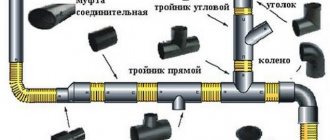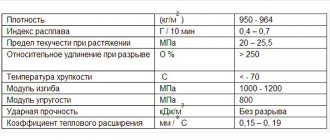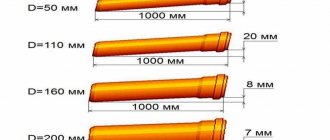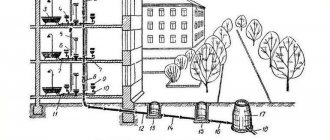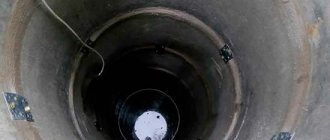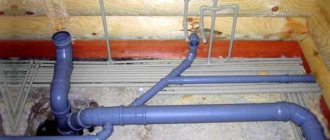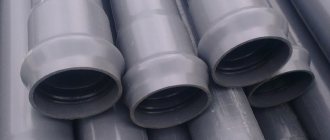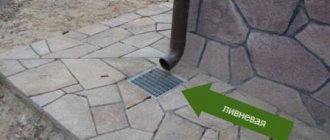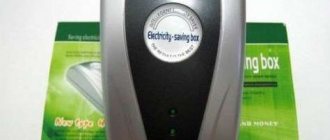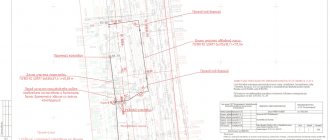Criterias of choice
The external pipeline operates in unfavorable street conditions. Incorrectly selected pipes for external sewerage can deform under soil pressure (during rising groundwater levels) or change properties due to severe frost. Violation of the integrity of the system will result in unexpected expenses for repairs (the damaged fragment will have to be replaced).
When designing external sewerage, they try to find a compromise between the need to ensure a long service life of the system and optimize costs. External sewerage pipes must meet the requirements for:
- strength (ability to withstand environmental stress);
- wear resistance (resistance to internal aggressive environment);
- affordability.
Double-wall corrugated polyethylene pipes
For external sewerage, drinking pipes made of PE-100 water supply with a pressure of up to 10 atm are used. For non-pressure external sewerage and drainage, you can use recycled technical pipes made of PE-63 or PE-80, or double-layer polyethylene pipes.
- Polyethylene drinking pipe PE-100 drinking with diameters from 20 mm to 63 mm in coils of 50 meters, 100 meters, 150 meters and 200 meters;
- Polyethylene drinking pipe PE-100 with diameters from 75 mm to 110 mm in coils of 50 meters and 100 meters;
- Polyethylene drinking pipe PE-100 with diameters from 50 mm to 1600 mm in sections of 12 meters;
- Technical polyethylene pipe PE-63 with diameters from 20 mm to 110 mm in coils of 50 meters and 100 meters;
- Polyethylene technical pipe PE-63 with diameters from 50 mm to 630 mm in sections of 12 meters or 13 meters;
Double-layer polyethylene pipes such as ECOPAL, KORSIS with outer diameters from 110 mm to 1200 mm in sections of 6 or 12 meters.
The wall thicknesses of PE 100 pressure pipes are determined according to GOST based on the operating pressure in the pipeline system and the ratio of the outer diameter to the wall thickness (SDR).
Types and characteristics
For external sewerage, several types of materials with different physical and chemical properties are used.
Cast iron pipes
A classic method of arranging a sewer system that has existed for decades. The widespread distribution of cast iron products was due to a complex of reasons:
- High mechanical strength and long service life.
- Resistant to temperature changes and aggressive environments.
- Easy installation.
Cast iron is expensive, heavy and efficient Source krasnodar.blizko.ru
With the development of technology, cast iron sewer pipes for external sewerage have lost relevance due to some features:
- Heavy weight, forcing the use of special equipment during assembly.
- A defect in the internal cavity, leading over time to a narrowing of the lumen.
Ceramic pipes
Ceramic pipelines have been known since antiquity. Modern factories produce ceramic products with a diameter of 100-600 mm, which have undoubted advantages:
- Service life 30-40 years.
- Easy installation and low installation cost.
- Chemical inertness, temperature stability and environmental friendliness.
- Low internal surface roughness.
Disadvantages of ceramic products:
- Fragility (before assembly they must be checked for cracks).
- Short length (increases the number of joints of external sewerage).
The fragility of ceramics is leveled by strict adherence to installation technology Source alemsohbet.co
Asbestos-cement pipes
Although the material contains asbestos fibers, their chemical bonding with cement makes the products safe. The advantages include:
- Light weight and easy installation.
- Durability.
- Low thermal conductivity (almost no problems with freezing).
- Resistance to aggressive environments.
The main disadvantage of asbestos-cement products is fragility. Mechanical loads (especially during transportation) are fraught with cracks and chipped edges.
Polypropylene pipes
Plastic polypropylene pipes (Russian name - PPR, international - PPR) are suitable for assembling an external sewer system in a country house. Their popularity is a consequence of their advantages:
- Long service life. Manufacturers guarantee 30-50 years of flawless operation.
- Light weight and elasticity. Savings on transportation and installation.
- Resistance to high temperatures (operating mode - 80°C; emergency short-term temperature of 100°C does not reduce service life).
Polypropylene - corrugated on the outside, smooth on the inside Source obustroeno.com
See also: Catalog of companies that specialize in water supply and sewerage.
- Chemical inertness. The material is resistant to corrosion and does not emit harmful substances.
- Smooth inner layer.
- Diversity. Selection of models and parts of any configuration. Options are available reinforced with fiberglass or aluminum.
Flaws.
- Products made from PPR cannot be bent. To organize bending or turning, tees and angles are used.
- A welding machine is used for connection. Thermal welding creates a seam that is uniform in structure.
Polyethylene pipes
Installation
If you comply with all building codes, this allows you to accurately install the external sewer system, as well as the service life of all parts. It is necessary that the pipeline has the correct slope. This slope allows wastewater to drain naturally. According to SNiP, the slope of the pipeline should be towards the well.
The slope of the pipeline is determined by the diameter of the communication installation and ranges from two to three centimeters per meter of structure.
Important! It is necessary, of course, to produce the diameter of the pipes that will be supplied to serve the house or area. There are diameter standards for sewers that serve different numbers of houses
There are diameter standards for sewers that serve different numbers of houses.
If wastewater is discharged from several private properties, then the diameter of the pipe must be at least two hundred millimeters. And if wastewater is discharged from one house, then the diameter of the pipes should be one hundred or one hundred and ten millimeters. If pipes are installed between wells, they must be placed level, without any slope. When designing, you need to draw up a plan for the movement of communications, not forgetting to mark the pipeline and nearby buildings on it.
It is also better to place the water collector close to the roadway, but only if you plan to equip a cesspool (it is usually pumped out by a sewer truck). If an external sewer system is installed at bends or at differences in depth, then an inspection well must be constructed. Also, inspection wells are installed in cases where the straight section of the pipeline is more than 25 meters. And such a well is called an intermediate well.
The pipeline along its entire length must consist of pipes of the same material. Because different materials have different thermal expansion and for this reason a pipeline with pipes made of different materials quickly collapses.
So we have described the basic rules for the arrangement of external sewerage. When arranging external sewerage and, indeed, installing all types of sewerage systems, it is recommended to follow these norms and rules. Because if there are deviations during installation, this can subsequently lead to accidents on the routes and equipment failure. And this is very bad.
Video description
The plastic variety (Russian name - PE, international - PE), is widely used in external drainage systems:
PVC pipes
Polyvinyl chloride sewer pipes (PVC in international transcription) are mainly used for arranging sewer systems in residential buildings. Among the advantages of such products are:
- long-term operational period (40-50 years);
- reduced flammability and ultraviolet resistance;
- resistance to corrosion and clogging;
- light weight and easy installation (easy to cut and bend).
Smooth PVC pipes are used where there is no heavy load on the ground Source yandex.by
When using, it is necessary to take into account some features of the products:
- The disadvantage that limits the use of PVC pipes is the high coefficient of thermal expansion (change in linear size under the influence of temperature). If the liquid is heated to 60°C or higher, the tightness of the joints decreases, which can lead to leakage.
- The plasticity of the material decreases at low temperatures. Operation of the pipeline without insulation is allowed in the range from 0 to -15°C.
Selection of pipes for sewer systems
Pressure sewer system
The main parameters that pipes must have:
- tightness;
- ease of installation;
- strength;
- corrosion resistance;
- resistance to chemically aggressive environments;
- resistance to electrocorrosion caused by the presence of stray currents;
- versatility;
- elasticity (resistance to water hammer);
- preservation of properties during the service life.
PVC-U sewer pressure pipes have all these properties. Connecting the system using sockets, into the grooves of which sealing gaskets are inserted, allows installation without expensive equipment, ensuring tightness. These pipes are resistant to ultraviolet radiation and aggressive chemical waste. The range of fittings makes it possible to connect with pipelines made of other materials.
PVC-U pipe and tee with a metal flange for connecting to a metal pipeline
The reliability and tightness of the external pressure sewer eliminates the possibility of a breakthrough and allows you to avoid the negative consequences of sewage leakage.
Gravity sewer system
Free-flow sewer pipes transport wastewater at temperatures up to 45°C by gravity. Pipes are divided according to their ring stiffness (classes SN2 to SN8). Orange color. The pipes are equipped with sockets with rubber seals. The free-flow sewerage system made of PVC pipes and fittings has all the necessary hydraulic and chemical parameters. Pipes for non-pressure sewerage are made from high-quality raw materials using automated equipment and comply with certificates for this type of product.
PVC pipes for free-flow sewerage
Advantages of sewerage with PVC pipes
The economic benefits of installing and using such a sewer system consist of:
- reducing transportation costs;
- saving consumables;
- low labor intensity during assembly;
- no operating costs.
Environmental safety during operation is also a valuable quality of products.
The appearance of PVC pipes has greatly simplified the organization of drainage Source remontsami.ru
External sewerage: sequence of work
- Preparing a trench for sewerage. Its depth depends on the depth of soil freezing, the occurrence of groundwater and other features of the site. According to SNiP P-G.3-62, laying is carried out 0.5 m below the freezing mark. For pipes with a diameter of 110 mm, the trench width is 0.6 m.
Checking the slope angle is an important part of installation Source oxu.az
- Pipeline installation. Starts from the foundation of the house; the pipes are connected in a suitable manner and laid with a slope. If the sewerage system is laid shallow, the pipeline is insulated. At the exit from the building, the pipe must be insulated.
- The slope angle is checked , then the trench is backfilled.
Check valve device
Improper installation and violation of the rules of operation of the drainage system leads to an emergency situation - a blockage. The contents of the pipes can move back with all the ensuing consequences on the 1st floor. Installing a sewer check valve helps avoid dramatic events.
A check valve allows fluid to flow only outward; the return flow of wastewater is reliably shut off. A valve with a diameter of 110 mm is mounted on a common pipe, and a valve with a diameter of 50 mm is mounted on each PVC drain pipe.
Valves are made from cast iron, brass or steel. Due to the widespread use of PVC pipes, the demand for cheap and durable PVC valves has increased. By design, check valves are:
- PVC valve. Mounted on both horizontal and vertical pipes. Inside there is a reciprocating locking part - a plate fixed at a slight angle. It bends under the pressure of the escaping liquid, and the reverse flow presses it, blocking the return movement.
- Ball valve. The locking mechanism is a metal ball. If back pressure occurs, it is pressed against the hole and blocks the flow.
Cross-section of a ball check valve Source aglant.ru
How to properly provide and install a vent pipe
When designing an internal sewerage system, it is necessary to take into account a number of requirements for the vent riser: - the diameter of the ventilation pipe must be larger or correspond to the diameter of the main collector (riser). In most cases for civil engineering this diameter is 110mm, in some cases 160mm; - to ensure air flow - sewer ventilation - the fan pipeline must be directly connected to the street atmosphere. Ventilation is ensured by differences in air densities, which in turn directly depend on temperature. As a result, in winter, the ventilation of the sewer network works as hard as possible; - it is not allowed to lead the vent pipe into the attic space; - combining the vent riser and ventilation ducts of the room is not allowed; - it is not allowed to lead the pipe into chimneys, stove pipes, etc.;
What SNiP 2.04.01-85 tells us: 17.18. Domestic and industrial sewerage networks that discharge wastewater into the external sewer network must be ventilated through risers, the exhaust part of which is discharged through the roof or prefabricated ventilation shaft of the building to a height, m: from the flat unused roof………. 0.3 pitched roof …………………………………………… 0.5 exploitable roof ……………………………………. 3.0 edges of the prefabricated ventilation shaft ……… 0.1 Exhaust parts of sewer risers located above the roof should be placed from openable windows and balconies at a distance of at least 4 m (horizontally). There is no need to provide wind vanes on ventilation risers.
